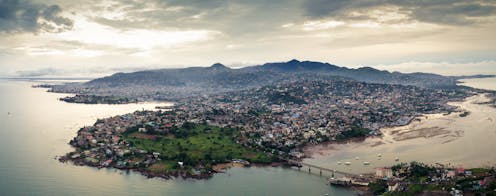
Eugenia Kargbo has an unusual job: she is the city of Freetown’s chief heat officer. Her role in Sierra Leone’s capital is the first of its kind in Africa. She has been tasked with raising public awareness about extreme heat, improving responses to heat waves, and collecting, analysing and visualising heat impact data for the city, which is home to 1.2 million people.
Freetown is increasingly threatened by dangerous temperatures. In 2017, the Intergovernmental Panel on Climate Change ranked Sierra Leone third, after Bangladesh and Guinea Bissau, on its list of countries most vulnerable to climate change.
The risks are concentrated in its capital and largest city, Freetown, where some 35% of the population live in 74 informal settlements like Kroo Bay, often in disaster-prone areas like the seafront or hillsides. Houses are densely built and typically temporary structures made of “heat traping” materials. Services that supports cooling, such as water and electricity, are usually inadequate.
As an architect whose work includes researching ways to reduce heat in African cities, I think the creation of an Heat Officer position is a good move. The world’s cities are almost all getting hotter – and, as the Intergovernmental Panel on Climate Change has warned, temperatures will only keep rising.
But, while this is a global challenge, African cities are unique. The significant proportion of urban dwellers who are poor and those whose living conditions do not provide adequate shelter from the elements make the African context unique and deserving special attention.
With these realities in mind, here are five things I’d suggest should be on the agenda of both Kargbo and any other heat officer appointed elsewhere on the continent in future.
1. Take a diverse approach to urban greening
Nature-based approaches are a great way to address increasing temperatures linked to climate change. Scholars have established positive links between green infrastructure, temperature moderation and even health outcomes in African cities as well as elsewhere in the world.
This has informed a growing number of tree-planting initiatives and the development of urban parks. But it is important that municipalities move beyond only these kinds of spaces. African cities are becoming densely populated; that means less space will be available for greening initiatives on land.
Vertical systems of building (for example on walls, roofs, columns) and urban infrastructure (for example on bridges, road furniture) should be explored to make up for the lack of space on the ground.
In the last few years, I have led the design and development of experimental vertical gardens in low-income areas of Nigeria and Tanzania. We have shown that these vertical gardens reduce wall temperature of residential buildings by as much as 5°C in Dar es Salaam. The gardens have other benefits like providing fresh vegetables for household consumption. Similar ways of growing vegetation vertically have been seen elsewhere in the world, including in Mexico City.
2. Strengthen the link between heat and health
Exposure to extreme heat usually comes with health problems – and can even kill people, as I and many other scholars have documented. It exacerbates underlying health conditions.
Read more: Heat stress is rising in southern Africa – climate experts show where and when it’s worst
One area of concern when it comes to the heat-health nexus in African countries is that mosquito numbers increase in higher temperatures. This means malaria and other diseases transmitted by mosquitoes might become significant problems for Freetown and other African cities.
These health problems are further complicated by the fact that many city dwellers across the continent can’t access adequate and affordable health care. Community health initiatives within cities and efforts to ramp up health services in qualitative and quantitative terms must be integral to heat adaptation plans and actions.
3. Focus on early warning and improved awareness
It is far better to be proactive than reactive. Heat vulnerability patterns within Freetown and other African cities must be studied and used to make sense of weather predictions in order to inform warning systems.
In the warning systems, for example, an alert level can be triggered when the weather forecast shows three or more consecutive days with daytime maximum temperature and humidity above a threshold of, say, 30°C. Other levels of alerts can correspond with higher temperatures. This sort of system has been implemented in Toronto, Canada, with good outcomes. A recent study of urban areas in Ontario (the province where Toronto is located) shows that early warnings may have meant fewer heat-related illnesses severe enough to warrant hospital or clinic visits.
4. Encourage the transfer of knowledge
Cities can adapt to heat faster when they share knowledge and experiences. Some scholars argue that inter-city collaboration and knowledge-sharing can enhance municipalities’ resilience and improve urban residents’ skills to deal with heat-related issues.
Kargbo’s work will generate many lessons that can be shared with other African cities; she, too, will learn from other cities’ successes and failures
Read more: Growing more plants and trees can cut down the heat in Nigerian cities
.
5. Let locals lead
While there is plenty to learn from more developed countries outside Africa, it is important to also draw from local indigenous knowledge and practices. An examination of knowledge and awareness about climate-related and environmental problems in African traditional society shows there is much to be learned from indigenous systems.
Top-down approaches are not enough. They must be complemented by bottom-up approaches in the planning, funding, execution and assessment of heat adaptation initiatives.
Inclusion is also important because it shifts power to those who are most affected by heat – people living in low-income and informal areas are disproportionately affected. Involving them enhances the impacts of initiatives and interventions.
Olumuyiwa Adegun previously received funding from African Academy of Sciences; DAAD ClimapAfrica Program; Commonwealth Futures Climate Research Cohort Programme
This article was originally published on The Conversation. Read the original article.







